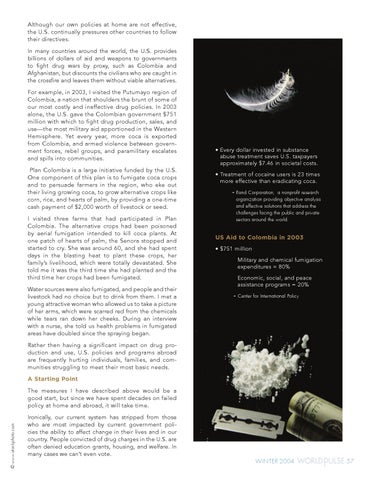Although our own policies at home are not effective, the U.S. continually pressures other countries to follow their directives. In many countries around the world, the U.S. provides billions of dollars of aid and weapons to governments to fight drug wars by proxy, such as Colombia and Afghanistan, but discounts the civilians who are caught in the crossfire and leaves them without viable alternatives. For example, in 2003, I visited the Putumayo region of Colombia, a nation that shoulders the brunt of some of our most costly and ineffective drug policies. In 2003 alone, the U.S. gave the Colombian government $751 million with which to fight drug production, sales, and use—the most military aid apportioned in the Western Hemisphere. Yet every year, more coca is exported from Colombia, and armed violence between government forces, rebel groups, and paramilitary escalates and spills into communities. Plan Colombia is a large initiative funded by the U.S. One component of this plan is to fumigate coca crops and to persuade farmers in the region, who eke out their living growing coca, to grow alternative crops like corn, rice, and hearts of palm, by providing a one-time cash payment of $2,000 worth of livestock or seed. I visited three farms that had participated in Plan Colombia. The alternative crops had been poisoned by aerial fumigation intended to kill coca plants. At one patch of hearts of palm, the Senora stopped and started to cry. She was around 60, and she had spent days in the blasting heat to plant these crops, her family’s livelihood, which were totally devastated. She told me it was the third time she had planted and the third time her crops had been fumigated. Water sources were also fumigated, and people and their livestock had no choice but to drink from them. I met a young attractive woman who allowed us to take a picture of her arms, which were scarred red from the chemicals while tears ran down her cheeks. During an interview with a nurse, she told us health problems in fumigated areas have doubled since the spraying began.
• Every dollar invested in substance abuse treatment saves U.S. taxpayers approximately $7.46 in societal costs. • Treatment of cocaine users is 23 times more effective than eradicating coca. - Rand Corporation, a nonprofit research organization providing objective analysis and effective solutions that address the challenges facing the public and private sectors around the world.
US Aid to Colombia in 2003 • $751 million Military and chemical fumigation expenditures = 80% Economic, social, and peace assistance programs = 20% - Center for International Policy
Rather then having a significant impact on drug production and use, U.S. policies and programs abroad are frequently hurting individuals, families, and communities struggling to meet their most basic needs. A Starting Point
© www.istockphoto.com
The measures I have described above would be a good start, but since we have spent decades on failed policy at home and abroad, it will take time. Ironically, our current system has stripped from those who are most impacted by current government policies the ability to affect change in their lives and in our country. People convicted of drug charges in the U.S. are often denied education grants, housing, and welfare. In many cases we can’t even vote.
WINTER 2004
57
